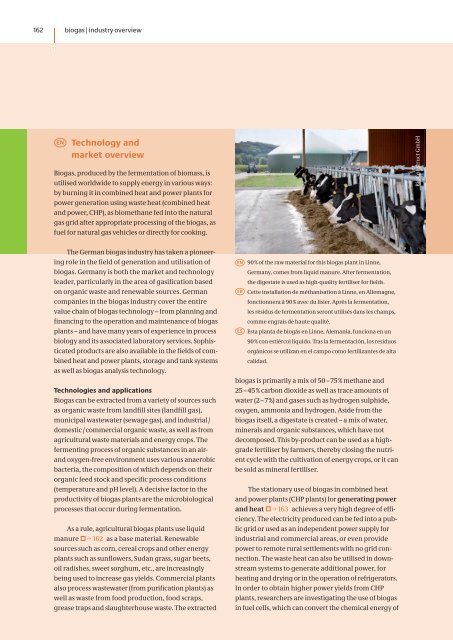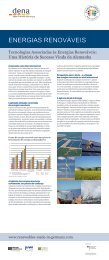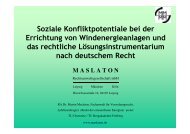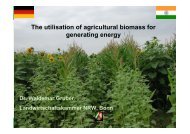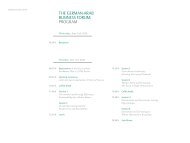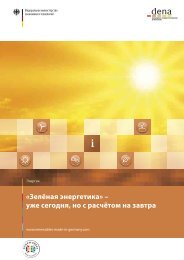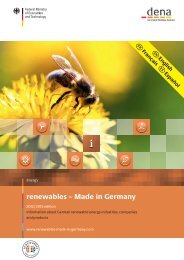renewables – Made in Germany
renewables – Made in Germany
renewables – Made in Germany
Create successful ePaper yourself
Turn your PDF publications into a flip-book with our unique Google optimized e-Paper software.
162 biogas | <strong>in</strong>dustry overview<br />
g Technology and<br />
market overview<br />
Biogas, produced by the fermentation of biomass, is<br />
utilised worldwide to supply energy <strong>in</strong> various ways:<br />
by burn<strong>in</strong>g it <strong>in</strong> comb<strong>in</strong>ed heat and power plants for<br />
power generation us<strong>in</strong>g waste heat (comb<strong>in</strong>ed heat<br />
and power, CHP), as biomethane fed <strong>in</strong>to the natural<br />
gas grid after appropriate process<strong>in</strong>g of the biogas, as<br />
fuel for natural gas vehicles or directly for cook<strong>in</strong>g.<br />
The German biogas <strong>in</strong>dustry has taken a pioneer<strong>in</strong>g<br />
role <strong>in</strong> the field of generation and utilisation of<br />
biogas. <strong>Germany</strong> is both the market and technology<br />
leader, particularly <strong>in</strong> the area of gasification based<br />
on organic waste and renewable sources. German<br />
companies <strong>in</strong> the biogas <strong>in</strong>dustry cover the entire<br />
value cha<strong>in</strong> of biogas technology <strong>–</strong> from plann<strong>in</strong>g and<br />
f<strong>in</strong>anc<strong>in</strong>g to the operation and ma<strong>in</strong>tenance of biogas<br />
plants <strong>–</strong> and have many years of experience <strong>in</strong> process<br />
biology and its associated laboratory services. Sophisticated<br />
products are also available <strong>in</strong> the fields of comb<strong>in</strong>ed<br />
heat and power plants, storage and tank systems<br />
as well as biogas analysis technology.<br />
Technologies and applications<br />
Biogas can be extracted from a variety of sources such<br />
as organic waste from landfill sites (landfill gas),<br />
municipal wastewater (sewage gas), and <strong>in</strong>dustrial /<br />
domestic / commercial organic waste, as well as from<br />
agricultural waste materials and energy crops. The<br />
ferment<strong>in</strong>g process of organic substances <strong>in</strong> an air-<br />
and oxygen-free environment uses various anaerobic<br />
bacteria, the composition of which depends on their<br />
organic feed stock and specific process conditions<br />
(temperature and pH level). A decisive factor <strong>in</strong> the<br />
productivity of biogas plants are the microbiological<br />
processes that occur dur<strong>in</strong>g fermentation.<br />
As a rule, agricultural biogas plants use liquid<br />
manure �p 162 as a base material. Renewable<br />
sources such as corn, cereal crops and other energy<br />
plants such as sun flowers, Sudan grass, sugar beets,<br />
oil radishes, sweet sorghum, etc., are <strong>in</strong>creas<strong>in</strong>gly<br />
be<strong>in</strong>g used to <strong>in</strong>crease gas yields. Commercial plants<br />
also process waste water (from purification plants) as<br />
well as waste from food production, food scraps,<br />
grease traps and slaughterhouse waste. The extracted<br />
g 90 % of the raw material for this biogas plant <strong>in</strong> L<strong>in</strong>ne,<br />
<strong>Germany</strong>, comes from liquid manure. After fermentation,<br />
the digestate is used as high-quality fertiliser for fields.<br />
f Cette <strong>in</strong>stallation de méthanisation à L<strong>in</strong>ne, en Allemagne,<br />
fonctionnera à 90 % avec du lisier. Après la fermentation,<br />
les résidus de fermentation seront utilisés dans les champs,<br />
comme engrais de haute qualité.<br />
e Esta planta de biogás en L<strong>in</strong>ne, Alemania, funciona en un<br />
90 % con estiércol líquido. Tras la fermentación, los residuos<br />
orgánicos se utilizan en el campo como fertilizantes de alta<br />
calidad.<br />
biogas is primarily a mix of 50 <strong>–</strong> 75 % methane and<br />
25 <strong>–</strong> 45 % carbon dioxide as well as trace amounts of<br />
water (2 <strong>–</strong> 7 %) and gases such as hydrogen sulphide,<br />
oxygen, ammonia and hydrogen. Aside from the<br />
biogas itself, a digestate is created <strong>–</strong> a mix of water,<br />
m<strong>in</strong>erals and organic substances, which have not<br />
decomposed. This by-product can be used as a highgrade<br />
fertiliser by farmers, thereby clos<strong>in</strong>g the nutrient<br />
cycle with the cultivation of energy crops, or it can<br />
be sold as m<strong>in</strong>eral fertiliser.<br />
The stationary use of biogas <strong>in</strong> comb<strong>in</strong>ed heat<br />
and power plants (CHP plants) for generat<strong>in</strong>g power<br />
and heat �p 163 achieves a very high degree of efficiency.<br />
The electricity produced can be fed <strong>in</strong>to a public<br />
grid or used as an <strong>in</strong>dependent power supply for<br />
<strong>in</strong>dustrial and commercial areas, or even provide<br />
power to remote rural settlements with no grid connection.<br />
The waste heat can also be utilised <strong>in</strong> downstream<br />
systems to generate additional power, for<br />
heat<strong>in</strong>g and dry<strong>in</strong>g or <strong>in</strong> the operation of refrigerators.<br />
In order to obta<strong>in</strong> higher power yields from CHP<br />
plants, researchers are <strong>in</strong>vestigat<strong>in</strong>g the use of biogas<br />
<strong>in</strong> fuel cells, which can convert the chemical energy of<br />
BioConstruct GmbH


